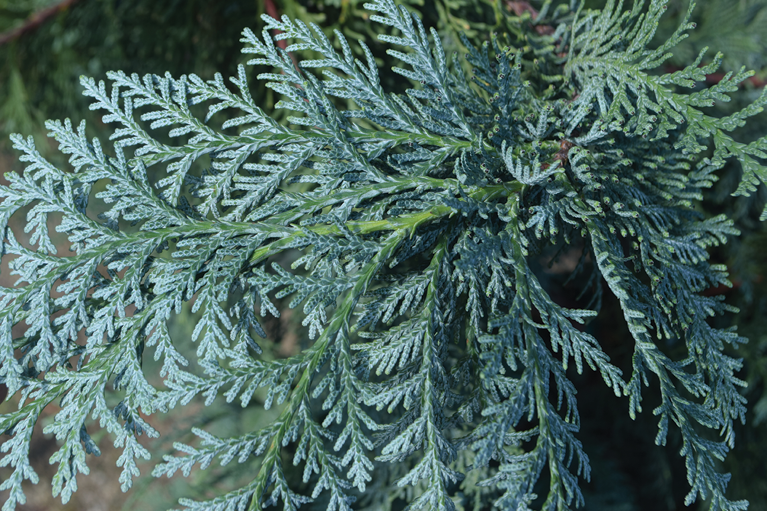
Photos: Michael A. Dirr T. occidentalis Planet Earth is a perfectly-rounded green meatball, 3 to 5 feet by 3 to 5 feet.
T. occidentalis Planet Earth is a perfectly-rounded green meatball, 3 to 5 feet by 3 to 5 feet.
Thuja sp. comprises five species: Thuja plicata, western arborvitae; T. occidentalis, eastern arborvitae; T. standishii, Japanese arborvitae; T. koraiensis, Korean arborvitae; and T. sutchuenensis, Chinese arborvitae. The formerly named Thuja orientalis is now Platycladus orientalis. At present, I have representatives of all but T. sutchuenensis in the garden. The Chinese species is extremely rare, was presumed extinct, until a single population was discovered in southwest China (Dabashan National Nature Preserve) in 1999. The species reaches 60 feet high with lustrous dark green foliage and occurs naturally on limestone mountains according to the Encyclopedia of Conifers. The climate in southwest China is warm, temperate and humid with 56 inches of annual rainfall. Royal Botanic Garden, Edinburgh, noted it was not in cultivation outside of China. However, a collector in New Hampshire reported it has “scarcely grown but persists and the deer love it.”
Thuja occidentalis is well represented in cultivation in the U.S. and new cultivars are introduced on a yearly basis. John Ruter, Horticulture, University of Georgia, introduced four cultivars with Passalora /Cercospora needle blight resistance. I observed or grow the following:
Lemon Burst (‘RutThu3’, PP35,206): New yellow growth, orange tones in winter. Grows 6 to 8 feet by 4 to 5 feet. Heat tolerant. Cold tolerant and survived -33°F in January, 2019 without winter burn. Pretty in a container as it holds the color in the heat of Zone 8. Listed as Zone 4 to 8. A First Editions introduction.
Planet Earth (‘RutThu4’, PP35,2970) is a perfectly-rounded green meatball, 3 to 5 feet by 3 to 5 feet. Assumes bronze-brown hues during winter. Densely branched and uniform in habit. Zone 4 to 8. A First Editions introduction.



Tall Guy (‘RutThu5’, PP35,180) is a moderate to fast growing, upright-columnar, green foliage selection. Reportedly, does not develop multiple leaders like ‘Emerald’, although I noticed many with multiple leaders at Griffith Propagation Nursery. Cold hardy to -33°F. Grows 8 to 12 feet by 2 to 3 feet. Zone 4 to 8. A First Editions introduction.
Thuja plicata is a non-factor in the southeast and for most of the eastern states. Does not appear as well adapted to humidity, drought, heat and heavy wet soils as T. occidentalis. As a parent of ‘Green Giant’ it provides luster to the foliage, degree of shade tolerance and a measure of deer resistance. Many years past, in Massachusetts, I discovered a rather pretty pyramidal seedling with lustrous dark green foliage among seedlings derived from T. plicata seed collected at the Hoyt Arboretum in Portland, Oregon. I shared plants with Mark Griffith of Griffith Propagation Nursery, Watkinsville, Georgia, who named it ‘Green Splendor’.
For curiosity’s sake I rummaged through several nursery web sites to determine the prevalence of T. occidentalis and T. plicata cultivars. Spring Meadow listed 15. Star Roses and Plants: 5. Monrovia: 33. Prides Corner Farm: 24. Overdevest Nurseries: 22. Eshraghi Nurseries: 21. Iseli Nursery: 20. Greenleaf Nursery Company: 20. Thuja occidentalis accounted for 90% of the total.



The history of ‘Green Giant’
The origin of this clone is rooted in a maze of misdirection and uncertainty. The path to introduction presented below is not a straight line. I recommend readers refer to the paper in Dendrobiology.
‘Green Giant’ and ‘Emerald’ dominate landscapes for hedges, screens and groupings across the U. S. ‘Green Giant’ originated from seedlings of T. plicata × T. standishii at the Horsholm Arboretum, Denmark, in 1938 according to Trees and Shrubs Online and Dendrobiology 8:113-121. (2022). The Dendrobiology article, “Thuja × soeegaardii (Cupressaceae)- a new name for an old hybrid”, traces the origin and history. In 1967, the National Arboretum received young plants of T. occidentalis ‘Giganteoides’ and seedlings of T. plicata × T. standishii from Poulsen’s Plant Nursery, Kvistgard, Sweden (American Conifer Society Bulletin 14:153-155. 1997), where “one of them developed into a particularly showy, lush, vigorous plant characterized by a dense, narrow conical crown.” I assume this original plant, distributed by the National Arboretum and enthusiastically promoted by the late J.C. Raulston, North Carolina State University, came from this population. It has superseded Leyland cypress in the South and most regions of the country.
The parents, T. plicata and T. standishii, bring unique traits to the hybrid including fast growth, uniform habit, shiny green foliage, as well as deer, insect and disease resistances. Mark Andrews, Greenleaf Nursery, Park Hill, Oklahoma, noted ‘Green Giant’ was resistant to foliar diseases in production when T. occidentalis and T. plicata were not. Soegaard (see Dendrobiology) showed the disease resistance in the hybrid was derived from T. standishii. Cuttings root readily, grow off with hybrid vigor and are quite wind firm. It has persisted in the heat and drought of the Southeast, although occasional dead plants surface in commercial and residential landscapes. Richard Olsen, director, U. S. National Arboretum, reported significant mortality in the Washington area from the 2024 drought. I did not observe this in the Athens area, although late summer and fall were extremely dry.
It is the dream plant for screening and hedging. I observed plants 40 feet high and 15 feet wide. Several references cite sizes ranging from 50 to 60 feet high and 12 to 20 feet wide with an average growth of 3 feet per year. I believe the plant is named appropriately.
The new scientific name, T. × soeegaardii, has not been accepted by GRIN, the taxonomic data base maintained by the USDA-ARS. If this happens, then ‘Green Giant’ becomes T. × soeegaardii ‘Green Giant’, which accurately distinguishes it from other hybrid seedlings.
Regardless of name, ‘Green Giant’ marches on and continues to develop sports that show landscape promise. Mark Andrews speculated that the instability of the genome (the entire set of DNA instructions found in the cell) has given rise to these sports. All should prove adaptable in Zones 5 to 8. There are others in trial at Greenleaf that have not been released.
Everyst (TPMTF’) from Moon Tree Farm, Washington, Georgia, develops a narrow conical habit, the foliage thickly set and lustrous dark green, maintaining good color in winter. Grows 35 to 40 feet high, 10 to 12 feet wide. Adapted to Zones 5 to 9. I work with Dwayne Moon, the owner, and visit the nursery frequently. I think this could replace ‘Green Giant’ where a tall but narrow screen or hedge is desired. Additionally, it carries the genetics for deer resistance. Dwayne licensed Greenleaf Nursery to produce container plants.



Green Screen (‘INGGSP’, PP35,388) is an Iseli Nursery, Boring, Oregon, introduction that grows half as fast as ‘Green Giant’ and develops a narrower silhouette. Described in the 2024-25 online catalog as developing an elegantly slender form with lush green foliage that tapers to a spire-like tip without pruning. Size listed as 10 feet by 3 feet.
Green Supreme reached 15 to 20 feet high and 4 to 6 feet wide in 15 years, Discovered by Paul Harrell, Creekside Farms Nursery, Jackson, N.C. Greenleaf Nursery is evaluating it.
Another useful sport of ‘Green Giant’ is ‘Junior Giant’ (PP31,297), a more compact, densely branched, full foliaged introduction. The plants I am growing appear bulletproof based on the foliage density. Listed as growing 15 to 20 feet high, 8 to 10 feet wide, half the size of ‘Green Giant’. Introduced by Stuart Burnley and Bill Neal of Hermitage Farms Nursery in Franktown, Virginia. Stuart reached out to me and offered to send plants for trial. I believe there is a place for this in smaller/restricted landscapes. In mid-November, I hosted the UGA landscape architecture woody plant class at PII. Never considered discussing the plant as I was focused on PII introductions but, surprisingly, several students asked about the plant.
‘Leprechaun’ (PP 33,840) arose in a production field of ‘Green Giant’ in Enfield, Connecticut, where it was discovered by Frank J. Kogut in 2014. The patent description mentioned slow growing, 10 feet by 5 feet, with dark green foliage and no winter bronzing. Several nurseries offer plants.
Virginian (‘BFC68’ PP26,684) is a sport I have yet to acquire. Photos depict a narrower habit than ‘Green Giant.’ Listed as growing 12 to 15 feet high, 4 to 6 feet wide in 10 years, requiring no pruning to maintain shape. Discovered by Frank Case, Plantation Spring Nursery, Suffolk, Virginia. Marketed through UpShoot.
Midwest Groundcovers described two introductions derived from ‘Green Giant’ seed. They are therefore hybrids of T. plicata × T. standishii. According to the Illinois nursery, an allée of hybrid seedlings was planted in 1999 at the entrance of the Rebill National Park in Denmark and, from these, the following were introduced. Photos show both selections being more open and graceful than the parent.



Nordic Spire (‘MGnrdspr15’) reaches 25 to 30 feet by 20 to 25 feet, mid to dark green foliage. Prone to winter discoloration. Columnar-conical habit with branchlets arching-pendulous. Zone 5 to 7.
Nordic Fourth of July (‘MGrebild19’) is the sister seedling to Spire with a central leader and more upright branches. Grows 25 to 30 feet by 12 to 15 feet. Zone 5 to 7.

Thuja koraiensis and T. standishii
The two species that are elusive in U.S. commerce and gardens are T. koraiensis and T. standishii. I read a research paper that grouped all the Thuja species closely together in a clade (grouping) using molecular markers. This means similar genetics and the possibility for hybridization. If T. plicata and T. standishii hybridize, why not the others? A combination of T. standishii and T. koraiensis would yield all manner of seedling treasures. I read mention of T. plicata × T. occidentalis hybrids but cannot cite an example.
I am particularly fond of T. koraiensis, Korean arborvitae, and continue to collect clones. The species is native to the Korean peninsula into China where it occurs in valleys and mountain ridges between 2,300 and 6,000 feet. Most forms are shrubby, although Iseli Nursery offers ‘Glauca’, a loosely pyramidal selection with graceful, arching, tertiary sprays of rich green foliage (upper) and silvery white needles below. The species reaches 30 feet high but is typically smaller under cultivation. Foliage like all Thuja is aromatic when bruised, this with the strong fragrance of “rich fruit cake with plenty of almonds” according to Trees and Shrubs Online. I asked Bonnie to describe needle odor. She likened it to a Christmas tree, which, in our area, means Fraser fir. Certainly, among Thuja species, the unique foliage with silver-backed needles is unmistakable.
In Europe, glaucous blue foliage specimens grow at the University of Utrecht Botanic Garden and Von Gimborn Arboretum. Photos show silver-blue on top and bottom of the sprays. I wrote Utrecht Botanic Garden inquiring about cuttings. I received a reply that there would be a follow-up and am patiently waiting.
Thuja koraiensis has been easy to root from cuttings. I rooted the low growing, shrubby form as well as ‘Glauca’, from November to January in 8 to 10 weeks. I used Root Gel (IBA +NAA in gel), bottom heat and well drained media. I have attempted to secure seeds with no good fortune. In general, Thuja species seeds require no cold stratification to germinate, but stratification may unify and hasten germination. With T. occidentals, seeds germinated when directly sown or in the plastic bag under cold moist stratification.
Thuja standishii, Japanese arborvitae, is even more elusive in commerce than T. koraiensis. Much larger (to 50 feet) than T. koraiensis where it grows in the mixed montane conifer-angiosperm forests of Honshu, Shikoku and Kyushu at 1,600 to 6,600 feet elevation, often confined to moist, rocky precipices on north facing slopes. The wood is highly prized for special building purposes. I once rooted cuttings of a pretty clone from the Missouri Botanical Garden which in Georgia turned yellow-brown-green in winter. Fast forward to Hampton Roads Agricultural Research and Extension Center, Virginia, where a beautiful 20-feet-high specimen magnetized me. At the University of North Carolina, Chapel Hill, N.C., there was a beautiful specimen in the Coker Arboretum. In 2017, I observed a 40-foot-high specimen on the Yale University campus. Under cultivation expect 20 to 30 feet, the habit pyramidal with pendent, bright green tertiary sprays hanging like curtains from the upswept branches. The Hampton Roads specimen was gracefully pyramidal and reminiscent of Cupressus nootkatensis (formerly Chamaecyparis nootkatensis). Foliage is shiny green above, matte/dull green below on the Hampton Roads selection. The crushed foliage is likened to the fragrance of lemon verbena.
I am unsure of absolute hardiness but based on sightings around the U.S., believe Zone 5 to 7(8) is reasonable for T. koraiensis and T. standishii. Our garden is in Zone 8a, and plants are performing well. Their future in the U.S. nursery industry resides in thoughtful, visionary breeding. Considering the impact of ’Green Giant’ on the nursery and landscape industries, there are opportunities for even greater treasures.
Opinions expressed are those of the author and do not necessarily represent GIE Media, Inc.
Get curated news on YOUR industry.
Enter your email to receive our newsletters.
Explore the February 2025 Issue
Check out more from this issue and find your next story to read.
Latest from Nursery Management
- Pennsylvania Horticultural Society announces 2025 Gold Medal Plant winners
- GIE Media Horticulture Group wins five regional 2025 Azbee Awards of Excellence
- Get to know Pat Reilly with NewGen Boxwood and the American Boxwood Society
- Terra Nova Nurseries introduces rust-free and disease-resistant heucherella
- John T. Nickel, founder of Greenleaf Nursery Co., passes away at 89
- Three tours offered at 2025 Farwest Show
- Garden Media Group announces sixth annual Women in Horticulture Week
- Star Roses and Plants announces National Knock Out Rose Day





